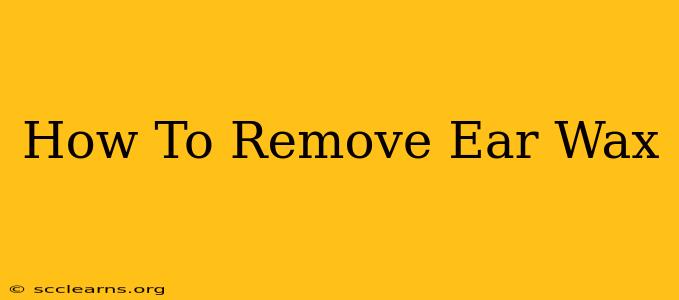Earwax, or cerumen, is a naturally occurring substance that protects your ear canal. While usually self-cleaning, sometimes wax buildup can lead to discomfort, hearing problems, or even infection. Knowing how to remove earwax safely and effectively is crucial. This guide will explain various methods and when you should seek professional help.
Understanding Earwax Buildup
Before we delve into removal methods, it's important to understand why earwax builds up. Excessive wax production, using cotton swabs (which actually push wax further in), or the natural shape of your ear canal can all contribute. Symptoms of excessive buildup include:
- Hearing loss: A feeling of fullness or muffled sounds.
- Earache: Pain or discomfort in the ear.
- Itching: An irritating itch inside the ear canal.
- Cough: In some cases, excessive earwax can trigger a cough.
- Ear ringing (tinnitus): A persistent ringing or buzzing in the ear.
Important Note: Never attempt to remove impacted earwax with sharp objects like bobby pins or toothpicks. This can cause serious damage to your eardrum and inner ear.
Safe and Effective Earwax Removal Methods
Several safe methods can help manage earwax buildup. Always proceed gently and stop if you experience pain.
1. Softening the Wax
The first step is often to soften the wax, making it easier to remove. You can do this with:
- Warm Water: Gently flush your ear with warm water using a bulb syringe or ear irrigation system. Ensure the water is lukewarm to avoid discomfort.
- Commercial Earwax Removal Drops: Pharmacies sell over-the-counter drops that help soften the wax. Follow the instructions on the packaging carefully.
- Hydrogen Peroxide (with caution): Diluted hydrogen peroxide can also help, but use it sparingly and only after consulting your doctor or pharmacist. It can cause irritation in some individuals.
2. Manual Removal (with caution)
After softening, you can try gently removing softened wax. Never insert anything into your ear canal beyond your outer ear.
- Soft Cloth: Gently wipe around the outer ear to remove any visible wax.
3. Irrigation (with professional guidance)
Ear irrigation involves flushing the ear canal with water to remove wax. While you can buy irrigation systems, it's best to have this done by a healthcare professional. Improper irrigation can damage your eardrum.
When to See a Doctor
While home remedies are often sufficient, certain situations require professional medical attention:
- Severe ear pain or discomfort
- Significant hearing loss
- Bleeding from the ear
- Signs of infection (e.g., pus, fever)
- Inability to remove wax with home remedies
- Recurring earwax problems
Your doctor can safely remove impacted earwax using specialized tools and techniques, such as ear curettage or microsuction. They can also diagnose and treat any underlying ear conditions.
Preventing Future Buildup
Preventing earwax buildup is often easier than dealing with it. Here are some helpful tips:
- Avoid using cotton swabs: They push wax further into the ear canal.
- Keep your ears clean: Regularly clean the outer ear with a soft, damp cloth.
- Don't use ear candles: There's no scientific evidence to support their effectiveness, and they can be dangerous.
By following these tips and seeking professional help when needed, you can keep your ears healthy and free from bothersome wax buildup. Remember, a little earwax is normal and protective; it's only excessive buildup that requires attention.

